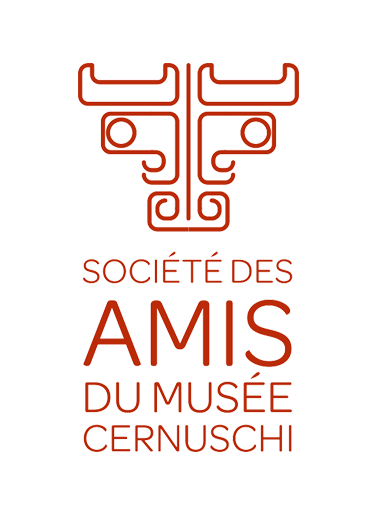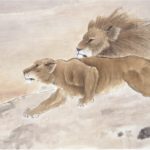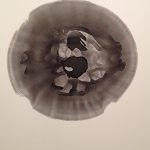The Caucasus and the influence of eastern nomads in the first millennium BC
Wednesday 11 March 2015: conference The Caucasus and the influence of the nomads of the East in the first millennium BC by Ana Cheishvili, Curator of Heritage, Archaeologist.
The purpose of this conference is to present the museum's nomadic art collection. From the 1920 years the collection has been enlarged by the entry of objects from Central Asia and the Caucasus region. In the 1960 years the museum bought a set of objects from a French archaeologist, Roman Ghirshman. It must be remembered that thanks to Mr. Gilles Béguin, three exhibitions were devoted to this geographical area. A catalog raisonné published in 2007 Animal art: High Asian collections of the Cernuschi museum presents collections that are not exhibited.
In the nineteenth century, the Caucasus region emerged as an important field of study in research related to Indo-European expansion and scientific societies such as museums undertook expeditions, hence the presence of many objects in different museums.
The Caucasus is a region of Eurasia made up of high mountain ranges (Elbrus 5 642m) which stretch from the Black Sea to the Caspian Sea; it is divided between the North Caucasus (Russian republics) and the South Caucasus ou (Armenia, Georgia and Azerbaijan). This region is very rich in copper and iron ores, which explains the development of metallurgy in this area. At the beginning of the first millennium a population of sedentary farmers occupied the Caucasus plains. The metallurgy of copper and bronze is very well documented at this time with the remains of copper processing workshops in ingots near the mining sites and the many objects found. The appearance of iron is first of all related to a decorative use (inlay of iron in bronze objects) and later, the appearance of iron weapons.
 |
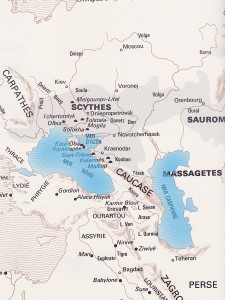 |
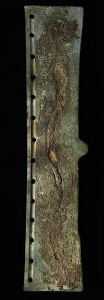 |
| Map of the Caucasus region | Scythians and Sarmatians | Buckle. Bronze with iron inlay. Caucasus. IX-VIIIth century BC. JC MC9304 |
Before the nomadic invasions one distinguishes in the south from the Greater Caucasus, the colchic culture and the kobane culture to the North. Even if they are similar and have similarities, Kobane culture seems to be linked to a pastoral people whereas colchic culture is associated with agriculture and sedentarisation. The kingdom of Colchis is mentioned in the Assyrian sources but is especially associated with the expedition of Jason and Argonauts for the conquest of the golden fleece sung by Pindar (518-438 BC) and Apollonius of Rhodes (295- 215 BC). This trip would have taken place at the end of the second millennium in Colchis. This kingdom was next to VIIIrd s. BC. JC of the kingdom of Ourartu located in the south.
The Caucasus was invaded by Cimmerian tribes in the VIIIrd century BC JC The Cimmerians or Proto-Scythians, nomadic horsemen originally from Ukraine were driven south by the Scythians and part crossed the Caucasus to then settle in Asia Minor while the other will cross the European continent and will be known like the Cimbri. According to Herodotus, the Cimmerians would have crossed the Caucasus along the Black Sea while, later, the Scythians would have skirted the Caspian Sea. Unfortunately there are no real traces of the passage of the Cimmerians in the Caucasus region. At the most, we associate the Cimmerian culture with the appearance of bimetallic daggers (iron blade on a bronze handle) and elements of harness. The François vase (570 BC) from the Archaeological Museum in Florence shows three archers wearing a high felt cap, one of which is called Kimerios. The Cernuschi Museum has for this period (beginning of the first millennium) bronze objects and a bronze belt buckle inlaid with an iron serpentiform pattern.
Objects from Luristan appeared in Europe around 1930 and came from looted graves. According to Ghirshman, the Cimmerians would have been linked with the peoples of Luristan settled in western Iran, but if this theory is abandoned today it will have allowed to enter a beautiful set of objects in the collections of the Cernuschi museum and allowed an exhibition in 2008. The art of the bronziers of Luristan is characterized by canonical objects: finger axes, pins, idols, bits and rings of harness, sharpener handles, swords. These objects are decorated with animal, human and fantastic figures.
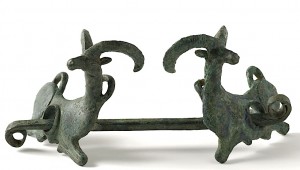 |
 |
| Mors. Bronze. Iran. IX-VIIIth century BC. JC MC7639 | Pinhead. Bronze and iron rod. Iran. IX-VIIIth century BC. JC MC 8831 |
The second wave of invaders crossing the Caucasus is Scythian. These highly mixed peoples would have occupied the Eurasian steppes and migrated as far west as Central Asia. The Assyrian sources mention them in VIIrd s. av. JC and Herodotus cite them as being located in the North of the Black Sea and describes them as a people of horsemen living on plunder. The Scythian culture is distinguished by three elements: the short sword (akinakes), the harnessing of horses and animal art. It is believed that this art was imported from the Eurasian steppes at the beginning of the VIIrd s. av. JC then enriched by contacts with Western Asia and Greece. The tombs (kurganes) located in Ukraine, in southern Russia but also in Altai have yielded a rich funerary furniture: weapons, elements of harness, metal crockery, jewelry, etc.
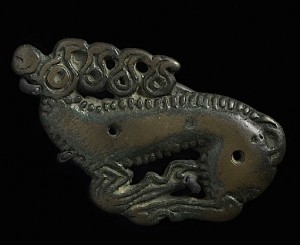 |
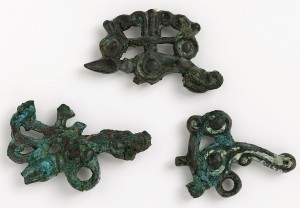 |
| Plate. Bronze. Southern Siberia. Ve s. BC. JC MC6599-4 | Pendants. Bronze. Caucasus. 4th century BC. JC MC 6845-1, MC 7504, MC6845-2 |
The presence of Scythians in the Caucasus is attested from the end of VIIrd century BC JC with discoveries of arrowheads, swords, battle axes, horse harnesses with a typical animal style decor. These objects were found in tombs, accompanied by elements of the local culture.
From the VIrd s. BC. In the South Caucasus there are traces of the destruction of the cities and it is probable that these destructions were caused by the Scythians when they crossed this region because we found tombs presenting Scythian furniture associated with objects characteristic of the local cultures. All Scythian artifacts are related to the war.
At Vrd and IVrd s. BC. Scythians are still present in the region of the Caucasus but they will be in their turn driven by the Sarmatians (or Sauromates) people of nomadic horsemen related to the Scythians and also from the Eurasian steppes. These will occupy the Scythian territory north of the Black Sea and if they had contacts with the Caucasus region they do not seem to have crossed.
